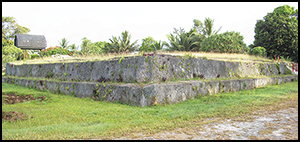Crossref Citations
This article has been cited by the following publications. This list is generated based on data provided by
Crossref.
Clark, Geoffrey
Parton, Phillip
Reepmeyer, Christian
Melekiola, Nivaleti
and
Burley, David
2018.
Conflict and State Development in Ancient Tonga: The Lapaha Earth Fort.
The Journal of Island and Coastal Archaeology,
Vol. 13,
Issue. 3,
p.
405.
Kahn, Jennifer G.
2019.
Encyclopedia of Global Archaeology.
p.
1.
Quintus, Seth
and
Clark, Jeffrey T.
2019.
Ritualizing Hierarchy: Power Strategies and Pigeon Catching in Ancient Samoa.
Journal of Anthropological Research,
Vol. 75,
Issue. 1,
p.
48.
Kahn, Jennifer G.
2020.
Encyclopedia of Global Archaeology.
p.
7385.
Clark, Geoffrey
Leclerc, Mathieu
Parton, Phillip
Reepmeyer, Christian
Grono, Elle
and
Burley, David
2020.
Royal funerals, ritual stones and participatory networks in the maritime Tongan state.
Journal of Anthropological Archaeology,
Vol. 57,
Issue. ,
p.
101115.
Valentin, Frederique
Clark, Geoffrey
Parton, Philip
and
Reepmeyer, Christian
2020.
Mortuary practices of the first Polynesians: formative ethnogenesis in the Kingdom of Tonga.
Antiquity,
Vol. 94,
Issue. 376,
p.
999.
Fenner, Jack N.
Herrscher, Estelle
Valentin, Frédérique
and
Clark, Geoffrey
2021.
An isotopic analysis of Late Lapita and State Period diets in Tonga.
Archaeological and Anthropological Sciences,
Vol. 13,
Issue. 1,
Martinsson-Wallin, Helene
2022.
Archaeological Perspectives on Conflict and Warfare in Australia and the Pacific.
p.
69.
Parton, Phillip
Clark, Geoffrey
and
Reepmeyer, Christian
2022.
Archaeological Perspectives on Conflict and Warfare in Australia and the Pacific.
p.
147.
Parton, Phillip
and
Clark, Geoffrey
2024.
Low-Density Urbanisation: Prestate Settlement Growth in a Pacific Society.
Journal of Archaeological Method and Theory,
Vol. 31,
Issue. 3,
p.
1485.
